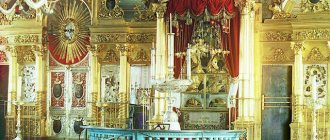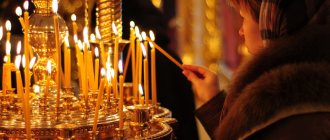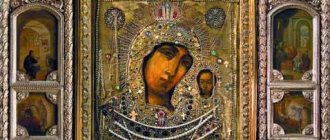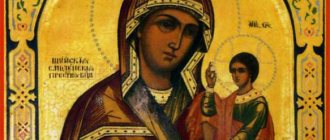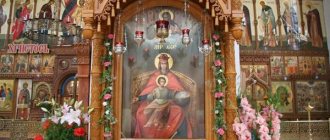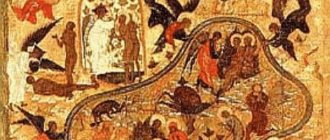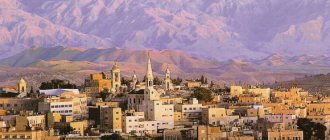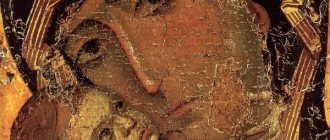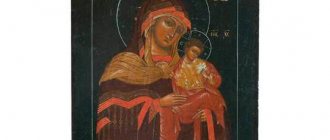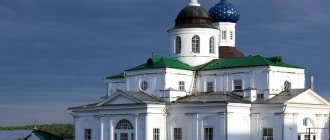The history of the Georgian Icon of the Mother of God goes back to the deep past. The exact time and place of its writing are unknown. Its original location was in Georgia, but when the country was conquered by the Persian Shah Abbas in 1622, this image, like other Georgian icons, was captured and taken away by the Persians, for whom the trade in Orthodox shrines became a profitable business.
The further history of the Georgian Icon of the Mother of God is truly full of miracles. Stefan Lazarev, who served as a clerk for the Yaroslavl merchant Grigory Lytkin, ended up in Persia on trade-related matters. A certain Persian brought an icon to Lazarev for sale. Because of the silver and gold frame, it was very expensive, but Lazarev, nevertheless, bought it.
The merchant Lytkin, his owner, had a prophetic dream about this event; he was ordered to donate the icon to the Krasnogorsk monastery near Arkhangelsk. The merchant, however, soon forgot about his prophetic dream, and only when four years later the clerk returned with the icon, he remembered the command from above and himself took it to the indicated monastery. He not only handed over the icon, but also built a church especially for it and purchased liturgical utensils and books.
And immediately the Georgian icon of the Mother of God showed a miracle: after long prayers before it, the blind and deaf monk Pitirim regained his sight and hearing. The miraculous image was carried at the head of religious processions not only throughout Central Russia, but was even brought to the Siberian Lena River.
In order to renew the painting on the icon and make a new robe for it, in 1654 it was delivered to Moscow, which was at that moment engulfed in a pestilence epidemic, and showed many miracles of healing.
The latest information about the Georgian Icon of the Mother of God dates back to 1946, when it was carried in a religious procession; then its traces are lost. However, the significance of the copies from the icon is also great: they showed many miracles, and therefore are considered miraculous.
The history of the appearance of the miraculous face
It is not known for certain who the author of the icon is and when it was painted. Its original location was Georgia. In 1622, the Georgian lands were conquered by the Persians during the reign of Shah Abbas. It was then that the holy image was transported to Persia, where local residents established a good trade in Christian shrines.
Icon of the Blessed Virgin Mary “Georgian”
- Three years later, one Slavic clerk, who came to Persia on merchant business, was offered to buy the image of the Mother of God. Stefan Lazarev could not refuse such an acquisition. He bought the icon in a silver-gold frame, although the price was quite high. Meanwhile, the Yaroslavl merchant Grigory Lytkin, for whom Lazarev served, had a strange dream. A voice in a dream ordered the merchant to deliver the image of the Mother of God to the Krasnogorsk Monastery on the Pinega River, not far from Arkhangelsk. The merchant did not take this dream seriously and soon forgot about it. And only upon the clerk’s arrival home, Lytkin remembered the instructions from above and immediately set off on the road to Arkhangelsk.
The merchant handed over the sacred image to the monks of the monastery. In addition, he built a church there at his own expense and bought all the church utensils and books.
- Subsequently, the icon of the Virgin Mary began to show miracles of healing. Monk Pitirim, who had not seen for a long time and had lost his hearing, fervently prayed before the face of the Queen of Heaven for healing from his ailments. And after reading the prayer, his sight and ability to hear returned. The rumor about the miraculous icon quickly spread throughout the area. Metropolitan Nikon of Novgorod, having familiarized himself with all the facts of the healing, appointed the celebration of the day of the Georgian Icon of the Mother of God for August 22.
Processions of the cross with the ancient icon went all the way to the Siberian forests. And in 1698, a decree was issued to bring the shrine to Arkhangelsk to consecrate the city and its inhabitants every year.
In 1654 they decided to restore the icon. She was transported to Moscow. At this time, the city was suffering from a pestilence epidemic. After the icon was brought, believing townspeople began to come to it on pilgrimage and received healing from a terrible illness.
Important! Numerous copies were made from the icon of the Mother of God, which proved to be miraculous.
During the revolutionary years of religious persecution, the Krasnogorsk monastery ceased to function, and the trace of the icon was lost. In 1946 they started talking about her again. According to the clergyman, a religious procession was carried out with the image from Arkhangelsk.
Some sources contain references to the fact that the Georgian icon of the Mother of God was kept in the Tretyakov Gallery until the end of the fifties. However, an audit in 1964 did not reveal the image among the gallery exhibits. Perhaps the USSR authorities sold it to foreign collectors or the icon was stolen.
More about the icons of the Mother of God:
- "Burning bush"
- "Desperate One Hope"
- "Kasperovskaya"
What else can you see
There are other attractions in Raifa. For example, a horse yard. If you want to ride horses or take some riding lessons, this is the place for you! The horses are beautiful and smart, and the horseback rides, according to reviews from those who have already been there, are simply amazing!
An arboretum has been established on the territory of the Raifa Nature Reserve in Kazan. It has existed here since 1921. In general, about 500 species of various trees, vines and shrubs grow on its area of 21 hectares.
The Raifa arboretum of Tatarstan is located in the village of Sadovoy, Zelenodolsk district. Coordinates: 55.90709, 48.74946. The arboretum is open every day except Monday. Its working hours are from 10 a.m. to 5 p.m. From 13 to 14 - lunch break.
I found an interesting and very colorful video on YouTube “24 facts about the history of Raifa.” Take a look, you'll like it.
Description of the icon
The Georgian icon of the Blessed Virgin Mary is close in iconography to other images of the Virgin Mary in Georgia from the 10th to 16th centuries, especially from Kakheti. She belongs to the Hodegetria type, which means "Guide". The icon radiates tenderness and a bright feeling of love.
Georgian icon of the Mother of God
Jesus sits on Mary's left hand. The Mother of God bows to the Baby, and He reaches out to Her and raises his right hand, blessing the Mother of God. Bare feet are visible from under the child’s clothes, one of which is turned to the viewer with its foot. In his left hand, Jesus holds a scroll, which symbolizes the good news for humanity.
What should we pray to the Mother of God for in front of the Georgian icon? prayer
The first icon that I will talk about this fall will be the icon of the Mother of God called “Georgian”. Each time I discover more and more new icons of the Most Holy Theotokos for myself and you, I fill my life with light and warmth, love. As my deeply religious brother says, God is where love is.
Let's learn another story of the miraculous icon, read the prayers and surround ourselves with the love that arises in the soul.
Georgian icon of the Mother of God. Icon painter Kirill Ulanov. 1707 (Tretyakov Gallery)
Kirill Ulanov - [1], Public domain, https://commons.wikimedia.org/w/index.php?curid=10014731Exact measurement list of the icon, 1707
The history of the icon has no roots and is lost somewhere in the deep past. Its first traces can be traced only in 1622, when the icon was taken out of Georgia after being captured by the Persians. By the will of fate, she first ended up in Yaroslavl, and later was sent to the Krasnogorsk monastery near Arkhangelsk. This is what the Mother of God herself ordered, coming in a dream to the merchant, the owner of the icon. And there the first miracle of healing from blindness and deafness of a local monk, who prayed incessantly before her, day and night, was performed. In 1654, the icon was sent to Moscow for restoration and saved the city from the pestilence that had gripped it at that time.
Unfortunately, in 1920 the monastery was destroyed and traces of two miraculous icons located there are lost - the Vladimir and the Georgian.
Ruins of the Krasnogorsk Monastery
Schekinov Alexey Victorovich (old nickname “Xxxl”) - Moved from ru.wikipedia to Wikimedia Commons by Michał Sobkowski using CommonsHelper., Public domain, https://commons.wikimedia.org/w/index.php?curid=18039627photo
Several copies have been made of the Georgian Icon of the Mother of God, some of which are considered miraculous.
You can find a list of the miraculous icon in the Tretyakov Gallery and in the Cathedral of Christ the Savior in Sokolniki. In Moscow in the Taganka Church. Also, a miraculous copy of the icon is located in the Raifa monastery near Kazan (Zelenodolsk district).
What to pray for in front of the Georgian icon?
In front of this icon you can ask for help in healing various ailments. Especially diseases affecting the eyes, ears, brain:
- pray for healing from emotional wounds and traumas
- about protection from general misfortunes and illnesses
- pray for healing of gastrointestinal diseases
- young couples pray for children and healing from infertility
Where is the holy image located?
The original of the icon has not survived to our time. Today in the Tretyakov Gallery there is an exact copy, corresponding in size to the original image. The list was made in 1707 by the isographer Kirill Ulanov.
Three other copies that turned out to be miraculous are also in Moscow:
- in the Church of the Life-Giving Trinity;
- in the Church of the Resurrection of Christ (Sokolniki);
- in the Church of St. Martin the Confessor.
The fourth and very revered copy of the image of the Mother of God is kept in the Raifa Monastery of the Mother of God. It was ordered by Metropolitan Lavrenty. According to monastic legends, a copy of the icon relieved mental disorders and mutilations of limbs, and restored vision on the way to the monastery.
Important! Many found consolation and received help after praying to this miraculous image, even when official medicine did not give any chance of recovery. This once again proves that God’s grace is limitless and only sincere faith can help in difficult life situations.
Renewal of the monastery
The monastery lived a calm, measured life until 1689. This year there was a fire in this area. Since all the buildings of the monastery were wooden, most of it was badly damaged. The monks were left without a roof over their heads, literally on the ashes.
Some of them then went to other churches and monasteries. But many, despite the difficulties, remained to restore their monastery. Then the decision was made to revive the stone Orthodox monastery.
And now, at the turn of the 17th and 18th centuries, a new architectural monastery complex appeared here, some parts of which still stand today. The first stone church of the Holy Fathers in Raifa and Sinai was built in 1708. The next to be built was the St. Sophia Church. It was located above the cells of the monastic brethren and had one peculiarity: it was so small that it could only accommodate 7 people at a time.
And in 1739, the monastery complex already consisted of 15 churches!
There were no long-term construction projects then. A little later, the Georgian Cathedral was rebuilt, as well as the gate bell tower about 60 meters high. Already at the beginning of the 20th century, the Trinity Cathedral was built.
It had unique acoustics. According to legend, the singing of the choir of brethren in the Church of the Holy Trinity could be heard for several miles around.
Before the revolution itself, the monastic brethren of the monastery numbered about 80 inhabitants.
Venerable Isaac of Optina
The Monk Isaac I was born into a patriarchal merchant family. Already a mature man, he entered Optina Pustyn as a novice under Elder Macarius. After the death of St. Macarius and St. Moses, Father Isaac became rector of the monastery. Under the weight of this burden, he, a lover of silence and solitude, was exhausted, but humbly carried this cross. Already being an abbot, the Monk Isaac did not perform any monastic affairs without the blessing of the elder and taught this to the brethren. If any of the brethren expressed dissatisfaction with the burden of obedience or grumbled about the monastic order, the Monk Isaac usually answered: “Brother! Take my keys and be in charge, and I will go and fulfill your obedience,” and so he admonished the rebellious one.
We advise you to study Prayer for all occasions
Monastery today
In 1918 the monastery was closed. Since the 1930s, its territory housed a prison for political prisoners, and later a colony for juvenile delinquents. In 1991, Raifa was the first to be revived in the Kazan diocese. During the 1990s, its architectural ensemble was restored and full-fledged monastic life was restored.
Now about 60 novices live in the monastery. It attracts both pilgrims and tourists from all over the country and even beyond. Many come to Raifa for the holy spring, others - to get peace of mind. Those who want to plunge into the ice hole come to the monastery for Epiphany.
Prayers
Troparion of Martyrs
voice 4
Thy martyrs, O Lord,/ in their suffering received incorruptible crowns from Thee, our God,/ having Thy strength,/ they overthrew the tormentors,/ crushed the demons of weak insolence./ With those prayers// save our souls.
Kontakion of the Martyr Agathonikos and others like him
voice 1
Having acquired a good title, O wise God, / you turned away from the evil men of faith, / not being afraid of torment, Agathonich is glorious, / you were the same good heir / and you accepted with those who suffered with you / worthy crowns.
Troparion of Saint Gorazd, Archbishop of Moravia
voice 2
The most worthy successor of your teacher Methodius, / of the Moravian Church, the Patron of the Moravian Church, / you were, Our Hierarch Great Father, / a wonderful pillar of Orthodoxy, / a martyr without shelter, / and having endured exile from his flock by treacherous men. / Far from his fatherland, the Moravian lands, / Having established the preaching of the dogma of divine Truth, / You united in the Spirit with your holy teachers Cyril and Methodius in the Kingdom of Heaven. / Pray for us, blessed ones, / who honor your memory with faith, / to pacify the world and save our souls.
Troparion of the Mother of God before Her Georgian (Krasnogorsk) Icon
voice 4
Today the Krasnogorsk monastery is brightly flaunting, / and the Raifa desert rejoices with it, / like the dawn of the sun, rising from the east, having received, O Lady, / Your miraculous icon, / with it you disperse the darkness of temptations and troubles from those that are crying out truly: / deliver our monastery and the whole country Christians from all the slander of the enemy/ and save our souls, as the Merciful Intercessor of the Christian race.
Kontakion of the Mother of God before Her Georgian (Krasnogorsk) Icon
voice 8
To You, the Most Chosen of all generations, Mother of God, / we offer songs of thanksgiving, / with the coming of Your honorable icon, Your servants, Mother of God, are illuminated, / but, as having an invincible power, / free us from all troubles, let us call You: / Rejoice, Bride Unbride.
Word of His Holiness Patriarch Kirill
Addressing the Christian community in Corinth, one of the centers of pagan cult, the Apostle Paul warns believers not to fall under the yoke of paganism, which is dangerous for spiritual life (see 2 Cor. 6:14).
But there are alien forces, alien ideas that can become a yoke for all of us. What exactly is someone else's yoke? This is something that contradicts the God-given moral nature of man. These are ideas, thoughts, actions, examples that run counter to this Divine program, which impose a different way of life, when sin suddenly appears as holiness, evil as good, when everything is mixed in a terrible and deadly combination, and a person who absorbs this deadly product becomes unviable, it loses something very important, it ceases to differ from an animal, it destroys the program embedded in its soul, in its mind by God
About the opening psalm
In the rite of worship, the opening psalm is so named because with it Vespers and, accordingly, the liturgical day begin. As a starting point, the holy fathers chose Psalm 103, in which the creation of the world and its Creator are glorified, “since at the end of the day it is fitting to give thanks for everything.” During the all-night vigil, the psalm is performed with special solemnity. At the beginning, in complete silence, the priest and deacon, with the Royal Doors open, are supposed to cense the entire temple (in modern practice, only the altar is censed in silence). The censing recalls the action of the Holy Spirit, hovering over the waters when there was no man yet praising his Creator. Then the psalm itself is sung (in modern practice, often only individual verses of the psalm). The open Royal Doors signify that man was destined for a heavenly state and joyful praise: “Bless my soul the Lord.” Then the Royal Doors are closed, which symbolizes the closing of the gates of heaven due to the Fall.
Holy Bible
2 Cor., 182 ch., VI, 11-16
11 Our lips are open to you, O Corinthians, our hearts are enlarged.
12 You are not cramped in us; but your hearts are tight.
13 In equal recompense, I say, as to children, you too will be distributed.
14 Do not be unequally yoked with unbelievers, for what fellowship has righteousness with iniquity? What does light have in common with darkness?
15 What agreement is there between Christ and Belial? Or what is the complicity of the faithful with the infidel?
16 What is the relationship between the temple of God and idols? For you are the temple of the living God, as God said: I will dwell in them and walk in them; and I will be their God, and they will be My people.
Mk., 4 credits, I, 23-28
23 In their synagogue there was a man possessed by an unclean spirit, and he cried out: 24 Leave him alone! What have you to do with us, Jesus of Nazareth? You have come to destroy us! I know You, who You are, the Holy One of God.
25 But Jesus rebuked him, saying, “Be silent and come out of him.”
26 Then the unclean spirit shook him and cried out with a loud voice and came out of him.
27 And they were all astonished, so that they asked one another, “What is this?” What is this new teaching that He commands even the unclean spirits with authority, and they obey Him?
28 And soon the report of Him spread throughout all the surrounding region in Galilee.
